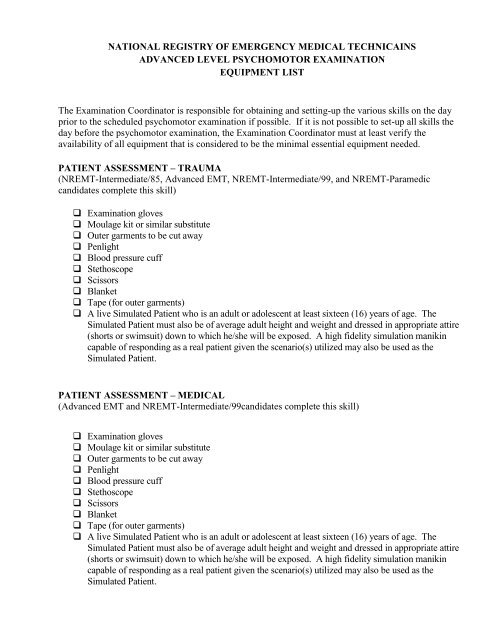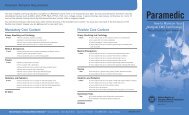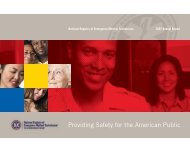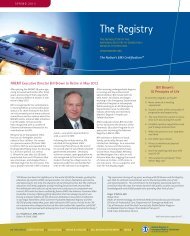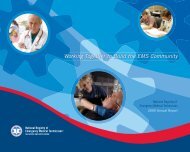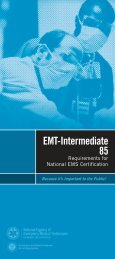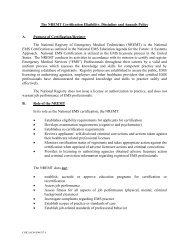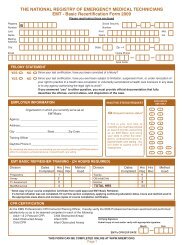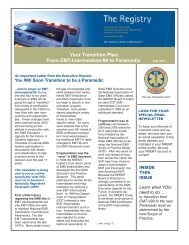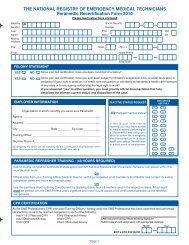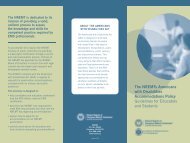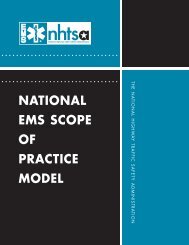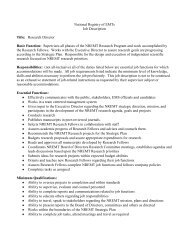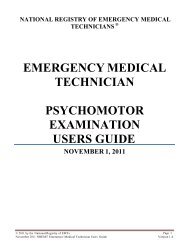Advanced Level Psychomotor Examination Equipment List
Advanced Level Psychomotor Examination Equipment List
Advanced Level Psychomotor Examination Equipment List
Create successful ePaper yourself
Turn your PDF publications into a flip-book with our unique Google optimized e-Paper software.
NATIONAL REGISTRY OF EMERGENCY MEDICAL TECHNICAINS<br />
ADVANCED LEVEL PSYCHOMOTOR EXAMINATION<br />
EQUIPMENT LIST<br />
The <strong>Examination</strong> Coordinator is responsible for obtaining and setting-up the various skills on the day<br />
prior to the scheduled psychomotor examination if possible. If it is not possible to set-up all skills the<br />
day before the psychomotor examination, the <strong>Examination</strong> Coordinator must at least verify the<br />
availability of all equipment that is considered to be the minimal essential equipment needed.<br />
PATIENT ASSESSMENT – TRAUMA<br />
(NREMT-Intermediate/85, <strong>Advanced</strong> EMT, NREMT-Intermediate/99, and NREMT-Paramedic<br />
candidates complete this skill)<br />
<strong>Examination</strong> gloves<br />
Moulage kit or similar substitute<br />
Outer garments to be cut away<br />
Penlight<br />
Blood pressure cuff<br />
Stethoscope<br />
Scissors<br />
Blanket<br />
Tape (for outer garments)<br />
A live Simulated Patient who is an adult or adolescent at least sixteen (16) years of age. The<br />
Simulated Patient must also be of average adult height and weight and dressed in appropriate attire<br />
(shorts or swimsuit) down to which he/she will be exposed. A high fidelity simulation manikin<br />
capable of responding as a real patient given the scenario(s) utilized may also be used as the<br />
Simulated Patient.<br />
PATIENT ASSESSMENT – MEDICAL<br />
(<strong>Advanced</strong> EMT and NREMT-Intermediate/99candidates complete this skill)<br />
<strong>Examination</strong> gloves<br />
Moulage kit or similar substitute<br />
Outer garments to be cut away<br />
Penlight<br />
Blood pressure cuff<br />
Stethoscope<br />
Scissors<br />
Blanket<br />
Tape (for outer garments)<br />
A live Simulated Patient who is an adult or adolescent at least sixteen (16) years of age. The<br />
Simulated Patient must also be of average adult height and weight and dressed in appropriate attire<br />
(shorts or swimsuit) down to which he/she will be exposed. A high fidelity simulation manikin<br />
capable of responding as a real patient given the scenario(s) utilized may also be used as the<br />
Simulated Patient.
VENTILATORY MANAGEMENT (ADULT & ALTERNATIVE AIRWAY DEVICE<br />
[SUPRAGLOTTIC AIRWAY])<br />
1. NREMT-Intermediate/85 candidates only complete one (1) adult scenario and can choose to<br />
place either a supraglottic airway device (Combitube ® , PTL ® , King LT ® ) or endotracheal tube.<br />
Requirements for state licensure may mandate which of these devices the NREMT-Intermediate/85<br />
candidate may use.<br />
2. <strong>Advanced</strong> Emergency Medical Technician (AEMT) candidates only complete one (1) adult<br />
scenario and are only authorized to place a supraglottic airway device (Combitube ® , PTL ® , King<br />
LT ® ).<br />
3. NREMT-Intermediate/99 and NREMT-Paramedic candidates must complete two (2) separate<br />
adult scenarios:<br />
a. Endotracheal intubation of the apneic adult patient<br />
b. Insertion of a supraglottic airway device (Combitube ® , PTL ® , King LT ® ) into an apneic<br />
adult patient<br />
<strong>Equipment</strong> for the Pediatric Ventilatory Management and Pediatric Respiratory Compromise Skills is<br />
listed separately in the Pediatric Skills section below.<br />
<strong>Examination</strong> gloves (may also add masks, gowns, and eyewear)<br />
Adult Intubation manikin<br />
Laryngoscope handle and blades (straight and curved of various sizes)<br />
Endotracheal tubes (6.0 - 8.5 mm)<br />
End-tidal CO 2 detector (waveform capnography or colorimetric) and/or esophageal detector<br />
device (EDD)<br />
Syringes (10 mL, 20 mL, 35 mL, etc.)<br />
Stylette<br />
Bag-valve-mask device with reservoir<br />
Oxygen cylinder with regulator (may be empty)<br />
Oxygen connecting tubing<br />
Selection of oropharyngeal airways<br />
Selection of nasopharyngeal airways<br />
Various supplemental oxygen devices (nasal cannula, non-rebreather mask with reservoir, etc.)<br />
Suction device with rigid and flexible catheters and appropriate suction tubing<br />
Sterile water or saline<br />
Supraglottic airway to include at least one (1) of the following:<br />
Combitube ®<br />
PTL ®<br />
King LT ® Oropharyngeal Airway or similar<br />
Stethoscope<br />
Lubricant (silicone spray)<br />
1/2" tape<br />
Spare batteries<br />
Tongue blade
CARDIAC MANAGEMENT SKILLS (DYNAMIC CARDIOLOGY, STATIC CARDIOLOGY,<br />
AND CARDIAC ARREST MANAGEMENT/AED)<br />
(NREMT-Intermediate/99 and NREMT-Paramedic candidates complete both Dynamic and Static<br />
Cardiology skills. Effective January 1, 2013, <strong>Advanced</strong> EMT candidates complete the Cardiac Arrest<br />
Management/AED Skill only.)<br />
These skills should be located in a quiet, isolated room with a desk or table and two (2) comfortable<br />
chairs. Prepared testing scenarios for the Dynamic portion and ECG tracings will be provided by the<br />
National Registry Representative. The manikin must be placed and left on the floor for these skills.<br />
Live shocks must be delivered if possible. If the monitor/defibrillator does not sense appropriate<br />
transthoracic resistance and will not deliver a shock, the Skill Examiner must operate the equipment to<br />
simulate actual delivery of a shock as best as possible.<br />
<strong>Examination</strong> gloves<br />
Monitor/defibrillator (no automated, semi-automated or interpreting machines permitted) with<br />
freshly charged batteries and spares<br />
Arrhythmia generator compatible with manikin and monitor/defibrillator<br />
Defibrillation manikin<br />
Conductive medium (gel, pads, etc.)<br />
ECG paper<br />
Effective January 1, 2013 for NRAEMT Candidates:<br />
Automated External Defibrillator (trainer model) with freshly charged and spare batteries<br />
CPR manikin that can be defibrillated with an AED Trainer<br />
ORAL STATION<br />
(Only NREMT-Paramedic candidates complete this station)<br />
These skills should be located in a quiet, isolated room with a desk or table and two (2) comfortable<br />
chairs. The Skill Examiner will sit across from and face the candidate during the testing in this station.<br />
The National Registry Representative will provide prepared testing cases and a barrier to prohibit any<br />
candidate from observing any case information or examiner documentation. Each candidate completes<br />
two (2) separate cases, each of which is conducted by a separate Skill Examiner.<br />
Tablet paper for candidate (All notes must be collected before dismissing the candidate from the<br />
room.)<br />
Pen or pencil for candidate<br />
Divider barrier (provided by NREMT) that prohibits candidate from observing any printed case<br />
materials or documentation<br />
Watch or visible clock with a second hand
IV AND MEDICATION SKILLS (IV THERAPY AND IV BOLUS MEDICATIONS)<br />
(NREMT-Intermediate/85 candidates only complete the IV Therapy Skill. <strong>Advanced</strong> EMT, NREMT-<br />
Intermediate/99 and NREMT-Paramedic candidates complete both the IV and Bolus Medication Skills.)<br />
<strong>Equipment</strong> for the Pediatric Intraosseous Infusion Skill is listed separately in the Pediatric Skills section<br />
below.<br />
<strong>Examination</strong> gloves<br />
IV infusion arm<br />
IV solutions*<br />
Administration sets**<br />
IV catheters***<br />
IV push medications (prefilled syringes)****<br />
Tape<br />
Gauze pads (2x2, 4x4, etc.)<br />
Syringes (various sizes)<br />
Tourniquet<br />
Alcohol preps or similar substitute<br />
Approved sharps container<br />
NOTE: Please refer to the essay for a detailed discussion of the following:<br />
* Need a selection array but may be expired<br />
** Need a selection array and must include microdrip tubing (60 gtt/cc)<br />
*** Need a selection array and can replace with small (20-22 ga.) catheters<br />
**** Must include atropine, epinephrine 1:10,000, naloxone, and dextrose 50% plus several others<br />
PEDIATRIC SKILLS (PEDIATRIC VENTILATORY MANAGEMENT, PEDIATRIC<br />
INTRAOSSEOUS INFUSION, AND PEDIATRIC RESPIRATORY COMPROMISE)<br />
(NREMT-Intermediate/99 and NREMT-Paramedic candidates complete the Pediatric Ventilatory<br />
Management Skill. Only <strong>Advanced</strong> EMT candidates complete the Pediatric Respiratory Compromise Skill.<br />
<strong>Advanced</strong> EMT, NREMT-Intermediate/99 and NREMT-Paramedic candidates complete the Pediatric<br />
Intraosseous Skill.)<br />
NOTE: These skills may be set-up as part of the Ventilatory Management Skills and the IV and<br />
Medication Skills.<br />
PEDIATRIC VENTILATORY MANAGEMENT<br />
<strong>Examination</strong> gloves (may also add masks, gowns, and eyewear)<br />
Infant intubation manikin<br />
Laryngoscope handle and blades (straight and curved of appropriate sizes)<br />
Endotracheal tubes (3.0 – 5.0 mm)<br />
End-tidal CO 2 detector and/or esophageal detector device (EDD)<br />
Syringes (10 mL, 20 mL)<br />
Stylette<br />
Bag-valve-mask device with reservoir<br />
Oxygen cylinder with regulator (may be empty)<br />
Oxygen connecting tubing<br />
Selection of oropharyngeal airways
Selection of nasopharyngeal airways<br />
Various supplemental oxygen devices (nasal cannula, non-rebreather mask with reservoir, etc.)<br />
Stethoscope<br />
Lubricant (silicone spray)<br />
1/2" tape<br />
Spare batteries<br />
Tongue blade<br />
Towel or other appropriate padding<br />
PEDIATRIC INTRAOSSEOUS INFUSION<br />
<strong>Examination</strong> gloves<br />
Intraosseous infusion manikin with replacement tibias (6 – 8 sticks/tibia)<br />
IV solutions*<br />
Administration sets**<br />
IV extension tubing or 3-way stopcock<br />
Intraosseous needles (Jamshidi ® , electric, drill-type and/or spring-loaded device)<br />
Syringes (various sizes)<br />
Tape<br />
Gauze pads (2x2, 4x4, etc.)<br />
Alcohol preps or similar substitute<br />
Bulky dressing<br />
Approved sharps container<br />
NOTE: Please refer to the essay for a detailed discussion of the following:<br />
* Need a selection array but may be expired<br />
** Need a selection array and must include microdrip (60 gtt/mL) tubing<br />
PEDIATRIC RESPIRATORY COMPROMISE<br />
<strong>Examination</strong> gloves (may also add masks, gowns, and eyewear)<br />
Infant manikin (approximately 1 year)<br />
Bag-valve-mask device with reservoir<br />
Oxygen cylinder with regulator (may be empty)<br />
Oxygen connecting tubing<br />
Selection of oropharyngeal airways<br />
Selection of nasopharyngeal airways<br />
Various supplemental oxygen devices (nasal cannula, non-rebreather mask with reservoir, etc.)<br />
Stethoscope<br />
Tongue blade<br />
Towel or other appropriate padding
RANDOM EMT SKILLS AND SPINAL IMMOBILIZATION (SUPINE PATIENT) SKILL<br />
Skills will be tested as follows but all equipment for all skills must be available. One (1) adult or adolescent<br />
who is at least sixteen (16) years of age must serve as the Simulated Patient for this skill. The Simulated<br />
Patient must also be of average adult height and weight.<br />
LEVEL<br />
NREMT-Intermediate/85, NREMT-Intermediate/99,<br />
NREMT-Paramedic<br />
<strong>Advanced</strong> Emergency Medical Technician<br />
SKILL(S) TO TEST<br />
Test one (1) of the following:<br />
• Spinal Immobilization (Seated Patient)<br />
• Spinal Immobilization (Supine Patient)<br />
• Bleeding Control/Shock Management<br />
All must test one (1) of the following:<br />
• Spinal Immobilization (Seated Patient)<br />
• Bleeding Control/Shock Management<br />
• Long Bone Immobilization<br />
• Joint Immobilization<br />
Additionally, all NRAEMT candidates must also<br />
test:<br />
• Spinal Immobilization (Supine Patient)<br />
SPINAL IMMOBILIZATION (SEATED PATIENT)<br />
<strong>Examination</strong> gloves<br />
Half-spine immobilization device* (wooden or plastic)<br />
Vest-type immobilization device*<br />
Padding material (pads or towels)<br />
Armless chair<br />
Cervical collars (correct sizes)<br />
Cravats (6)<br />
Kling, Kerlex, etc.<br />
Long immobilization straps (6 of any type)<br />
Tape (2" or 3" adhesive)<br />
Blankets (2)<br />
*It is required that the skill include one (1) plain wooden or plastic half board with tape, straps,<br />
blankets, and cravats as well as one (1) common vest-type device (complete). Additional styles<br />
and brands of devices and equipment may be included as a local option.<br />
BLEEDING CONTROL/SHOCK MANAGEMENT<br />
<strong>Examination</strong> gloves<br />
Field dressings (various sizes)<br />
Bandages (various sizes)<br />
Tourniquet (commercial or improvised)<br />
Oxygen cylinder with delivery system (tank may be empty)<br />
Oxygen delivery devices (nasal cannula, simple face mask, non-rebreather mask)<br />
Blanket<br />
Gauze pads (2x2, 4x4, etc.)
Kling, Kerlex, etc.<br />
<strong>Examination</strong> gloves<br />
Rigid splint materials (various sizes)<br />
Roller gauze<br />
Cravats (6)<br />
Tape<br />
LONG BONE IMMOBILIZATION<br />
<strong>Examination</strong> gloves<br />
Cravats (6) to be used as a sling and swathe<br />
JOINT IMMOBILIZATION<br />
SPINAL IMMOBILIZATION (SUPINE PATIENT)<br />
<strong>Examination</strong> gloves<br />
Long spine immobilization device (long board, etc.)<br />
Head immobilizer (commercial or improvised)<br />
Cervical collar (appropriate size)<br />
Patient securing straps (6-8 with compatible buckles/fasteners)<br />
Blankets<br />
Padding (towels, cloths, etc.)<br />
Tape


